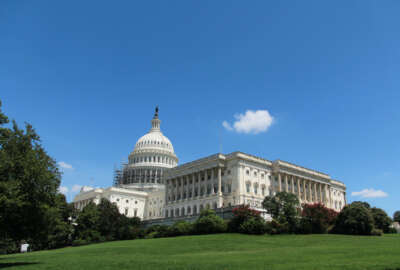GSA’s strategy for OASIS leaving vendors discontented
At an industry sponsored event, GSA tried to clarify its plans for the multi-billion dollar governmentwide contract, which will let agencies buy complex services...
wfedstaff | April 17, 2015 4:38 pm
The General Services Administration is putting the final touches on its next governmentwide, multi-billion dollar contract, called OASIS.
A draft request for proposals is expected in the coming month or so. But a room full of vendors yesterday walked away from a discussion on the highly-anticipated procurement with more questions than answers. A panel of GSA officials couldn’t put their concerns about the concept behind OASIS to rest.
Several questions emerged during the two-hour discussion sponsored by the Professional Services Council, TechAmerica, ACT-IAC and the Coalition for Government Procurement in Arlington, Va. Two of the biggest ones centered on how does OASIS fit into the Obama administration’s strategic sourcing initiative, which has mostly focused on commodity products and services, and how will GSA determine price standardization around many of the services under the vehicle? 
The goal of OASIS is to let agencies buy complex solutions under one contract. For example, an agency could buy engineering, IT and management consulting services under OASIS. There is no governmentwide acquisition vehicle that allows for that today.
Agencies now have to either do a full and open competition or do some sort of hybrid contract through existing GWACs or schedules where they have to buy the services separately but keep them related. GSA estimates OASIS could have a ceiling of $60 billion over 10 years.
Answers are coming
GSA tried to answer vendors’ questions or concerns over the path OASIS is taking.
Jim Ghiloni, the director of the OASIS program office, preached patience until the draft RFP comes out in the next few months and tried to answer questions the best he could.
“What we are talking about capital ‘s’ and small ‘s’ for strategic sourcing. Some of the concepts of strategic sourcing involve understanding your spend, gathering data and trying to establish a common vocabulary. These are the things when we talk about strategic sourcing in the OASIS context that we are referring to,” he said in an interview with Federal News Radio after the event. “We’re not talking about establishing a single mandatory vehicle. We’re not talking about economies of scale across large volumes like you would when you are buying a commodity.”
Ghiloni said the use of the term strategic sourcing is as much about market research than anything else.
The goal is to create OASIS so agencies can buy these complex services better than at any time before.
Price ranges for less complex services
The second big question around price standardization was more difficult for GSA to address and vendors to accept the explanation. 
Trey Hodgkins, a senior vice president for public policy at TechAmerica, said OASIS’ concept remains unclear as it seems GSA is trying to treat complex services like pens and pencils.
Lena Trudeau, GSA’s associate commissioner for the Office of Strategic Innovations in the Federal Acquisition Service, said OASIS and the use of strategic sourcing is about being more intentional about what and how products and services are bought and used.
Trudeau added when different parts of the same agency are buying the same product or service from the same vendor, but paying significantly different prices, that’s a problem, and it’s something OASIS is trying to resolve.
Trudeau added GSA expects different services or services that have different levels of complexities not to have similar costs.
“At the same time, we have the ability and the responsibility to the extent possible, we are getting smarter about what we buy, and that is what this is about,” she said.
More data, better decisions
Soloway asked how GSA is determining the right price range, especially with the pressure on agencies to use lowest-price technically acceptable instead of best value.
Ghiloni said he expects the ranges to apply only to labor hours and time and materials types of contracts, which are expected to be only a small part of the job functions under OASIS. He said most of that will be bought under firm fixed price.
“Our expectation is that there is one right rate for a labor category, but defining a standard labor category doesn’t mean that you then assign a rate to it and that’s the rate everyone has to use,” he said. “Standardized labor categories let us talk to each other and give us a standard vocabulary. There’s a bell curve of rates and there always will be one. By gathering data on actual usage and actual bids, we can look at that bell curve, publish that data and the expectation is the bell curve shrinks. If you are at the high end or low end, you will want to understand why.”
He added contracting officers then will have the data and tools needed to make better decisions, by asking better questions about why a vendor’s labor rate in one area is on the high end of the range. The vendor also will expect that question and be more ready to explain the value that high price would bring to the agency.
Data collection in process
GSA is figuring now what exact data it needs, ensuring it can capture the information that is available and not have to make new requests to industry, and making sure its processes are in place to capture it and reduce the burden on industry. Ghiloni said GSA is using the model from the Alliant contract that has worked well.
Ghiloni said GSA also is working with other agencies, such as the Commerce Department’s Bureau of Labor Statistics, to collect existing government data first before deciding what it needs to collect from industry.
Ghiloni wouldn’t give a more exact date for when GSA would release the draft RFP, but he said many of the concerns expressed by industry would be addressed when it is released.
Of course, it also will open up a new round of questions too. The one question that remains unanswered is whether OASIS is needed.
Soloway said he’s not sure.
“I heard two things today. One was the agencies were all saying, ‘If I had a vehicle where I could strategically buy professional services, I’d do it.’ I didn’t hear them saying, ‘If there was a vehicle where I could buy complex professional services integration support, which is what OASIS is about, I would do that,'” he said. “I think identifying the entire market for professional services as a market for OASIS is questionable for reasons that are fairly clear, which is a lot of professional services are not tied to a complex solution. So we don’t know the answer yet. I think GSA is doing exactly the right thing to move down this path and I think they should push hard, which drives the hard questions back. But they have to be ready to be flexible and back up when they’re not ready and I think what we saw in the discussion today is that there is a general agreement that is the case.”
RELATED STORIES:
GSA targets small businesses for new IT contracts
GSA’s OASIS contract to streamline professional services offerings
Copyright © 2024 Federal News Network. All rights reserved. This website is not intended for users located within the European Economic Area.
Jason Miller is executive editor of Federal News Network and directs news coverage on the people, policy and programs of the federal government.
Follow @jmillerWFED






